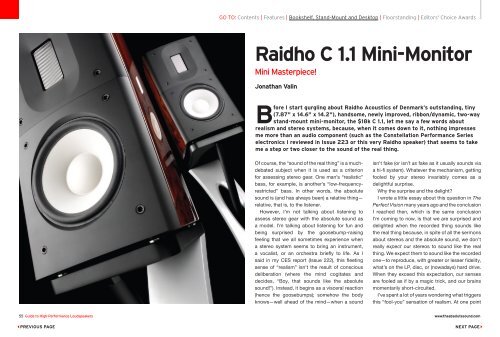LOUDSPEAKERS
Create successful ePaper yourself
Turn your PDF publications into a flip-book with our unique Google optimized e-Paper software.
go to: Contents | Features | Bookshelf, Stand-Mount and Desktop | Floorstanding | Editors' Choice Awards<br />
Raidho C 1.1 Mini-Monitor<br />
Mini Masterpiece!<br />
Jonathan Valin<br />
Bfore I start gurgling about Raidho Acoustics of Denmark’s outstanding, tiny<br />
(7.87" x 14.6" x 14.2"), handsome, newly improved, ribbon/dynamic, two-way<br />
stand-mount mini-monitor, the $18k C 1.1, let me say a few words about<br />
realism and stereo systems, because, when it comes down to it, nothing impresses<br />
me more than an audio component (such as the Constellation Performance Series<br />
electronics I reviewed in Issue 223 or this very Raidho speaker) that seems to take<br />
me a step or two closer to the sound of the real thing.<br />
Of course, the “sound of the real thing” is a muchdebated<br />
subject when it is used as a criterion<br />
for assessing stereo gear. One man’s “realistic”<br />
bass, for example, is another’s “low-frequencyrestricted”<br />
bass. In other words, the absolute<br />
sound is (and has always been) a relative thing—<br />
relative, that is, to the listener.<br />
However, I’m not talking about listening to<br />
assess stereo gear with the absolute sound as<br />
a model. I’m talking about listening for fun and<br />
being surprised by the goosebump-raising<br />
feeling that we all sometimes experience when<br />
a stereo system seems to bring an instrument,<br />
a vocalist, or an orchestra briefly to life. As I<br />
said in my CES report (Issue 222), this fleeting<br />
sense of “realism” isn’t the result of conscious<br />
deliberation (where the mind cogitates and<br />
decides, “Boy, that sounds like the absolute<br />
sound!”). Instead, it begins as a visceral reaction<br />
(hence the goosebumps); somehow the body<br />
knows—well ahead of the mind—when a sound<br />
isn’t fake (or isn’t as fake as it usually sounds via<br />
a hi-fi system). Whatever the mechanism, getting<br />
fooled by your stereo invariably comes as a<br />
delightful surprise.<br />
Why the surprise and the delight<br />
I wrote a little essay about this question in The<br />
Perfect Vision many years ago and the conclusion<br />
I reached then, which is the same conclusion<br />
I’m coming to now, is that we are surprised and<br />
delighted when the recorded thing sounds like<br />
the real thing because, in spite of all the sermons<br />
about stereos and the absolute sound, we don’t<br />
really expect our stereos to sound like the real<br />
thing. We expect them to sound like the recorded<br />
one—to reproduce, with greater or lesser fidelity,<br />
what’s on the LP, disc, or (nowadays) hard drive.<br />
When they exceed this expectation, our senses<br />
are fooled as if by a magic trick, and our brains<br />
momentarily short-circuited.<br />
I’ve spent a lot of years wondering what triggers<br />
this “fool-you” sensation of realism. At one point<br />
55 Guide to High-Performance Loudspeakers www.theabsolutesound.com<br />
previous page<br />
NEXT page

















